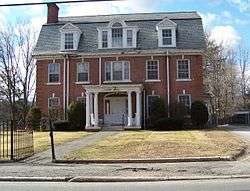Migeon Avenue Historic District
The Migeon Avenue Historic District encompasses a group of elegant residential properties on a one-block stretch of Migeon Avenue in Torrington, Connecticut. Consisting of five properties and four contributing primary buildings, this area was home to some of Torrington's leading businessmen at the turn of the 20th century. The houses are of high architectural quality, and original landscaping was done by the Olmsted Brothers landscape design firm. The district was listed on the National Register of Historic Places in 2002.[1]
Migeon Avenue Historic District | |
 Pease House, in 2010 | |
  | |
| Location | Roughly along Migeon Ave. and part of Forest St., Torrington, Connecticut |
|---|---|
| Coordinates | 41°48′30″N 73°7′46″W |
| Area | 13 acres (5.3 ha) |
| Architect | Olmsted, Frederick Law, Jr. |
| Architectural style | Shingle Style, Colonial Revival |
| NRHP reference No. | 02000913[1] |
| Added to NRHP | September 6, 2002 |
Description and history
The Migeon Avenue Historic District is located northwest of downtown Torrington. It consists of two properties on the east side of Migeon Avenue between Gleason and Forest Streets, one just north of Forest Street, and another two on the west side opposite Forest Road. The three properties on the east side are characterized by their landscaping and setback of the main building, except for the northernmost, where the original main house has been torn down and replaced by a modern assisted living facility. The two properties on the west side are on smaller lots and set closer to the road.[2]
The largest of the properties, Laurelhurst, was first acquired and developed as his residence by Henry Migeon, an textile manufacturer. Migeon's son Achille had the present large Shingle-style house built in the late 1890s, and retained the Olmsted Brothers to landscape the property. Achille sold the parcel just north of Laurelhurst to Thomas Bryant, who built a Colonial Revival house and also hired the Olmsted Brothers to do landscaping. The Bryant house was demolished in 1966 to make way for the nursing home. The parcel south of Laurelhurst was sold by Achille to Luther Turner, who also built a large Shingle-style house. The two houses on the west side of Migeon Avenue are elegant Colonial Revival houses, built by Harlow Pease, a local builder, and Frank Travis, president of the local water and electric companies.[2]
Gallery
 Laurelhurst, from the side, in 2010
Laurelhurst, from the side, in 2010 Travis House
Travis House
References
- "National Register Information System". National Register of Historic Places. National Park Service. March 13, 2009.
- Kate Ohno, with Carol Clapp and Cheryl Barb (March 2001). "National Register of Historic Places Inventory-Nomination: Migeon Avenue Historic District". National Park Service. and Accompanying 10 photos, exterior and interior, from 2000 and other